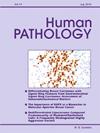Clinical use of circulating tumor DNA analysis in patients with lymphoma
IF 2.7
2区 医学
Q2 PATHOLOGY
引用次数: 0
Abstract
The analysis of circulating tumor DNA (ctDNA) in liquid biopsy specimens has an established role for the detection of predictive molecular alterations and acquired resistance mutations in several tumors. The low-invasiveness of this approach allows for repeated sampling and dynamic monitoring of disease evolution. Originating from the entire body tumor bulk, plasma-derived ctDNA reflects intra- and interlesional genetic heterogeneity. In the management of lymphoma patients, ctDNA quantification at various timepoints of the patient’s clinical history is emerging as a complementary tool that may improve risk stratification, assessment of treatment response and early relapse detection during follow-up, most prominently in patients with diffuse large B-cell lymphoma or classic Hodgkin lymphoma. While liquid biopsies have not yet entered standard-of-care treatment protocols in these settings, several trials have provided evidence that at least a subset of lymphoma patients may benefit from the introduction of liquid biopsies into daily clinical care. In parallel, continuous technological developments have enabled highly sensitive ctDNA assessment methods, which span from locus-specific techniques identifying single hotspot mutations, to sequencing panels and genome-wide approaches that explore broader genetic and epigenetic alterations. Here, we provide an overview of current methods and ongoing technical developments for ctDNA evaluation. We also summarize the most important data from a selection of clinical studies that have explored the clinical use of ctDNA in several lymphoma entities.
循环肿瘤 DNA 分析在淋巴瘤患者中的临床应用。
对液体活检标本中的循环肿瘤 DNA(ctDNA)进行分析,在检测多种肿瘤的预测性分子改变和获得性抗药性突变方面发挥着重要作用。这种方法的低侵袭性允许重复采样和动态监测疾病的演变。血浆来源的ctDNA源自全身肿瘤块,反映了区域内和区域间的遗传异质性。在淋巴瘤患者的治疗中,ctDNA 在患者临床病史不同时间点的定量分析正在成为一种补充工具,可改善风险分层、治疗反应评估和随访期间的早期复发检测,这在弥漫大 B 细胞淋巴瘤或典型霍奇金淋巴瘤患者中最为突出。虽然液体活检尚未进入这些领域的标准治疗方案,但多项试验已提供证据表明,至少有一部分淋巴瘤患者可从将液体活检引入日常临床治疗中获益。与此同时,技术的不断发展使高灵敏度的ctDNA评估方法成为可能,这些方法包括识别单个热点突变的特异性位点技术,以及探索更广泛遗传和表观遗传改变的测序面板和全基因组方法。在此,我们将概述ctDNA评估的现有方法和正在进行的技术开发。我们还总结了一些临床研究中最重要的数据,这些研究探讨了ctDNA在几种淋巴瘤实体中的临床应用。
本文章由计算机程序翻译,如有差异,请以英文原文为准。
求助全文
约1分钟内获得全文
求助全文
来源期刊

Human pathology
医学-病理学
CiteScore
5.30
自引率
6.10%
发文量
206
审稿时长
21 days
期刊介绍:
Human Pathology is designed to bring information of clinicopathologic significance to human disease to the laboratory and clinical physician. It presents information drawn from morphologic and clinical laboratory studies with direct relevance to the understanding of human diseases. Papers published concern morphologic and clinicopathologic observations, reviews of diseases, analyses of problems in pathology, significant collections of case material and advances in concepts or techniques of value in the analysis and diagnosis of disease. Theoretical and experimental pathology and molecular biology pertinent to human disease are included. This critical journal is well illustrated with exceptional reproductions of photomicrographs and microscopic anatomy.
 求助内容:
求助内容: 应助结果提醒方式:
应助结果提醒方式:


